Superflat: The Aesthetic Reaction to Post-War Japan
When someone starts naming aspects that make up a culture, sometimes art is easily forgotten or thrown at the bottom of the list. However, art is an incredibly important part of a country’s culture. It documents major historical events, categorizes the general feelings of the populace, provides social commentary, and illustrates a country’s traditions and way of life. Art is a mirror of culture; it materializes the overall presence of a nation and puts it on a national and international stage, allowing the rest of the world to witness the culture at hand. By focusing on pieces from certain time periods, the condition of the nation can be interpreted by examining its art. In the years after World War II, Japan underwent some major domestic and societal changes; the people’s reaction to this change was reflected in the nation’s art. This major post-war Japanese art movement is called Superflat and its meaning and interpretations truly show the discord and upheaval Japan was experiencing at the time.
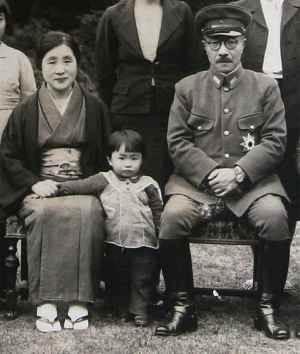
Firstly, the stage must be set. Japan was suffering severely in the years after World War II. After taking the hit of atomic bombs on two of Japan’s major cities and suffering a stifling defeat by the Allies, Japan was physically, emotionally, and economically destroyed, forced to begin rebuilding her nation from scratch. One of the first major changes in society that resulted from the war was the laws of inheritance. Japan was a patriarchal society so typically the first son in the family would inherit all entities from his parents when they passed. However, World War II resulted in most the first sons being killed in battle or as civilian casualties, so the law was changed to give equal inheritance to all children. This embedded a sense of independence within the younger generation; each child, male and female, was finally favored equally. This gust of individualism generated a surge of nationalism in the country as it started to reconstruct its way of life and, more importantly, its economy. Men and women alike began working and striving to rebuild Japan, allowing the economy to slowly work towards her recovery, a process which would begin in the early 1950’s.
Before the war, Japan was focused on industrialization and westernization, trying to catch up to the wealthy western powers and the rest of the world. This goal became the nation’s aspiration as she worked to return to the forefront of industrial leaders. Villages became towns, towns became cities, and cities became economic powerhouses. Farming slowly became a less common profession; the age of the samurai permanently turned into the age of the businessman and, by the end of the 1950’s, Japan was rising, returning to her state before the war. The nation was becoming more industrial and more western which was working in her favor. Japan would finally restore the honor she lost in her devastating defeat in 1945.
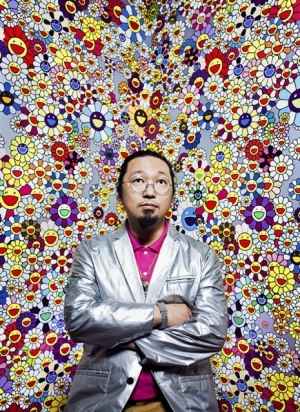
However, the economic boom in the 1950’s was not accepted by all; for some it angered them and magnified their rage at the world and trauma. People believed that Japan was losing its fundamental values, the values it was founded on, and was throwing them away to mimic the societies of those who defeated them. Takashi Murakami, a famous Japanese pop culture artist, was disgusted by Japan’s modernization:
I think that those who were able to enjoy consumer culture and the world of consumerism were in the countries that were victorious in the war. And by the countries that were victorious in the war I mean the U.S. and the British. Societies that lost the war, like Japan, envied the consumerism of the winners but they still wanted at least to be able to borrow what they envied (“The [Art] World is [Super] Flat”).
Murakami felt that the influx of consumerism and western thought was not caused by the spirit of nationalism but by jealousy of the success of Japan’s conquerors, which only defiled Japan’s honor instead of restored it. The new lifestyle of Japan was only covering the nation’s wounds instead of healing them. These feelings of cynicism spurred Murakami and others to express themselves through their paintings. With Japan’s modernization, the country was losing the aspects of her culture that made her unique, enriching and honorable. The culture was losing her complexity, distinctive dimensions and color; the culture was becoming flat. And thus the Superflat movement was born.
Although major changes in Japanese society began in the 1950’s, Superflat originated when Murakami moved to New York City in 1984 and exposed himself to the American pop art scene. Delving into his newfound encounters with American art and his experience with Japanese anime and manga, Murakami combined these elements while sketching in his studio and began to inspire other artists to attempt using this mix. Sharing the same annoyance with Japanese society, many attributed to the Superflat movement and agreed that this would be a beneficial way to express their views. The pieces have been exhibited internationally, recently in 2000 in Los Angeles and 2011 in New York City.
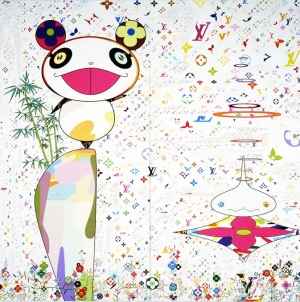
Superflat artists began creating pieces that mocked Japanese consumerism and attempted to remind Japan of her roots, her trauma, and her need to keep her individuality. The art form takes familiar images in the new Japanese society and skews them to reiterate that the nation was heading in the wrong direction. In Figure 1, The World of Sphere by Murakami, the Japanese economy is being mocked. Louis Vuitton and other commercial icons float in the background, showing the insignificance and superficial nature of the industry. In the foreground is a panda, embodying the cutesy style of advertising for which Japanese billboards and commercial are known. It reiterates the senseless, unhealthy focus on appearances in the culture and its lack of any meaningful substance.
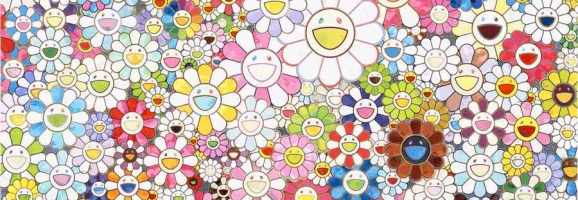
A second well known example of Superflat art is another piece by Murakami shown in Figure 2, Flower Superflat. Again, it shows that Japan is becoming a nation like all the others. Represented in the identical flowers, Japan is slowly becoming an indistinguishable flower in a bouquet, losing all the colors and qualities that made her unique, thus losing her individuality. The consumer culture and lack of traditional values and morals does not make Japan stand out from the other countries anymore. The country is becoming “super flat.”
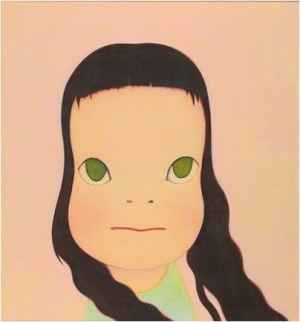
Another artist who contributed to the Superflat movement is Yoshitomo Nara. Abiding to his signature style of incorporating wide-eyed children into his paintings, Figure 3, Wind, embodies the disapproval and hatred some Japanese felt about the lack of values in their society. The subject’s expressionless face and convicting glare may only seem to superficially illustrate a child unexpectedly woken up from a nap, but its unwavering gaze in relation to the time period is a testament to the lack of enthusiasm over foundational changes in the country. The plain background and simple lines speaks in the same way Figure 2 does; Japan is becoming unoriginal and her war wounds may never be truly healed.
Superflat, which has become an iconic part of Japanese cultural history, conceptualized and materialized the nation’s flaws and turn from cultural values, showing part of the population’s disapproval of Japan’s societal changes. All the pieces that make up this movement, Murakami’s included, reflect the discomfort of the culture as it treads the unknown waters of capitalism, commercialism and westernization. Within the Superflat movement, the artists hope that Japan will see the errors in her ways and return to a more dignified way of running society, where character and discipline were more important than finances and success. The art of this time allows the world to learn about this little piece of Japanese history and start to understand why it is the nation it is today, whether it is a good or bad result.
Works Cited
Haden-Guest, Anthony. “The (Art) World Is (Super) Flat: Takashi Murakami on His Art Philosophy and Upcoming Charity Auction.” Gallerist. Web. 25 Apr. 2014.
“Japanese Economic Takeoff after 1945.” Indiana University Northwest. Web. 25 Apr. 2014.
Matsubara, Haruo. “The Family and Japanese Society after World War II.” Web. 24 Apr. 2014.
What do you think? Leave a comment.










Such an interesting article, I love being entertained while I learn. Great work Mary!
Thanks so much! And thanks for your revisions! They were super helpful! I’m glad you enjoyed it~
If anyone is interested in looking at or understanding Japanese art today, this article could be a good leadway.
Murakami is an interesting character and his work and manifesto is a must read for those interested in contemporary art, Japanese or otherwise.
Murakami describes the eccentric element as a construction or way of seeing; and with artworks, the way they present to the viewer. The idea is that a distinct Japanese point of view was developed over centuries to emerge Super-Flat.
Looking forward to Takashi Murakami’s first feature film, Jellyfish Eyes.
Me too! I’m pumped~
What a great film! We saw it yesterday at the ICA in Boston!
There’s no denying that Murakami makes interesting observations about Japanese society and history in his written work, but these are perhaps distinct from the what the art pieces themselves offer. The self-branding of “superflat” is perhaps the key problem – turning it into a money-churning enterprise that may depend more on hype and branding then actual content.
Thank you for your article I was not familiar with the term Superflat as an artistic expression. It is accurate and reflective. Art is a reflection of its culture. Sometimes the reflection is accurate and other times it is manipulated such as Western art that bound the hands of the artist. Commissioned pieces were where of the aristocratic and of the church and left their mark on society that when future generations look back their view of the culture is skewed.
Great article, the Superflat movement really puts into perspective the apprehensions of Japan after WWII. I was not familiar with the movement before this article, and now I think I could better grasp some of the complex tensions Japan is grappling with even today.
Thanks for this article. I’m currently studying Superflat and Murakami and I learned a lot from this post.
Awesome! I’m glad~~ Thanks for checking it out!
Great piece Mary.
I may have to call on you later this summer as I am preparing for a class. I am creating a lecture on the use of propaganda in comic books in the US and Japan and this may be an interesting way to transition to the work after propaganda.
Sure! I can’t say I’m an expert with this at all but I can try to help the best I can~! Thanks for reading!
I love Takashi’s works and own some ltd editions..
I love Murakami’s art.
Murakami’s work is absolutely mind-blowing and the more commercial his work becomes, the more i like it strangely enough. i was fortunate enough to see it in on display at the brooklyn museum of art, and it was the best $10 i’ve ever spent. i would have paid $100. no joke.
Nice summary of the movement. Murakami is one of my favourite contemporary artists and must be the most famous contemporary Japanese artist right now.
It’s wonderful getting behind the brush of Murakami; my favorite visual artists of all time. His work speaks for itself.
Most Japanese may not be able to know why he is special.
Even a comic artist who sells ten million copies is not seen as an artist.
I have long been a fan of Japanese contemporary pop-art, and am an artist myself.
Thank you this is a great article. It summarizes some aspects of The Superflat Art Movement, which has been a great inspiration to my own work.
Flower Superflat has to be one of my favourite pieces. It is just such a gorgeous picture. Also amazing article really spelled out the super flat movement especially to someone like me who had only seen a couple of pieces and didn’t know the full story
Thank you for this article. I had never really seen more than a few pieces of work from this movement, and not gotten around to learning the full story. Your article is fascinating and a wonderful look at the development. Thanks for writing 🙂
I love the whole superflat movement.
Really interesting. Superflat, too, has influenced some artists in the Americas. In particular, check out Baja California painter, Jaime Cárbo Marchesini. I wrote about him last year for a publication in San Diego. He uses indigenous imagery and tries––at times––to create an aesthetic somewhat inspired by Superflat.
Great article. Really informative and well-researched.
Love this article and learning more about Murakami in Art History at the moment
There is some nice context about post-war Japanese culture and society.